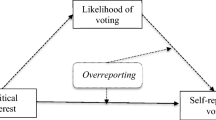Abstract
It is generally accepted that an increase in the amount of voter information is desirable. As Reisman (1990) points out, a well-informed and committed electorate is better able to exercise rational choice and consequently is less likely to have its wishes being thwarted by elected representatives. In this connection, a crucial question relates to the effect of increased voter information on power of elected representatives. In other words, does increased voter information dilute or increase the power of political parties? From the answer to this question flow numerous conclusions about the size of rents enjoyed by political parties under differing electoral systems.
We use data from Sicilian provincial elections (1985 and 1990) to examine the empirical relationship between voter information and power dilution. We use Olson's theory of groups to derive measures of voter information, following a methodology developed in Mudambi, Navarra, and Nicosia (1996). We use a measure of power dilution proposed by Capron and Kruseman (1988) and suggest an adjustment to correct it for truncation bias. We then examine the relationship between voter information and power dilution.
Similar content being viewed by others
References
Achen, C.H. (1975). Mass political attitudes and the survey response. American Political Science Review 69: 1218–1231.
Amemiya, T. (1985). Advanced econometrics. Cambridge, MA: Harvard University Press.
Barzel, Y. and Silberg, G. (1973). Is the act of voting rational? Public Choice 16: 51–58.
Breusch, T. and Pagan, A. (1979). A simple test for heteroscedasticity and random coefficient variation. Econometrica 47: 1287–1294.
Breusch, T. and Pagan, A. (1980). The LM test and its applications to model specification in econometrics. Review of Economic Studies 47: 239–254.
Brosio, G. and Ferrero, M. (1995). Un'interpretazione della Politica Italiana: Un Regime di' Nomenklarura' in un Sistema Democratico. Economia Pubblica 2: 5–32.
Capron, H. and Kruseman, J.L. (1988). Is political rivalry an incentive to vote? Public Choice 56: 31–43.
Cox, G.W. and Munger, M.C. (1989). Closeness, expenditures and turnout in the 1982 U.S. House elections. American Political Science Review 83: 217–231.
Downs, A. (1957). An economic theory of democracy. New York: Harper & Row.
Erikson, R.S. (1979). The SRC panel data and mass political attitudes. British Journal of Political Science 9: 89–114.
Frey, B.S. (1971). Why do high income people participate more in politics? Public Choice 11: 101–105.
Frey, B.S. (1972). Political participation and income level: Reply. Public Choice 13: 119–122.
Greene, W. (1993). Econometric analysis, 2nd ed. New York: Macmillan.
Harrington, J.E. (1992). The revelation of information through the electoral process: An explanatory analysis. Economics and Politics 4: 255–276.
Husted, T.A., Kenny, L.W. and Morton, R.C. (1995). Constituent errors in assessing their senators. Public Choice 83(3–4): 251–271.
Jacobson, G.C. (1978). The effects of electoral campaign spending in congressional elections. American Political Science Review 72: 469–491.
Mudambi, R., Navarra, P. and Nicosia, C. (1996). Plurality versus proportional representation: An analysis of Sicilian elections. Public Choice 86(3–4): 341–357.
Navarra, P. (1994). Competizione Politica e Gruppi di Interesse: Contratti Idiosincratici e Regole Elettorali tra gli Agenti del Mercato Politico. In G. Sobbrio (Ed.), Modelli Organizzativi e Intervento Pubblico, 213–225. Milano: Giuffre'.
Olson, M. (1965). The logic of collective action. Boston: Harvard University Press.
Palfrey, T. and Poole, K. (1987). The relationship between information, ideology and voting behavior. American Journal of Political Science 31: 511–530.
Patterson, S.C. and Caldeira, G.A. (1983). Getting out the vote: Participation in gubernatorial elections. American Political Science Review 77: 675–689.
Regione Siciliana (1987). =Elezioni dei Consigli delle Amministrazioni Straordinarie delle Province dei Consigli Comunali e dei Consigli di Quartiere nella Regione Siciliana - 12 Maggio 1985. Palermo: Assessorato Enti Locali.
Regione Siciliana (1992). =Elezioni dei Consigli delle Province Regionali, dei Consigli Comunali e dei Consigli di Quartiere nella Regione Siciliana dal 26 Maggio 1985 al 2 Dicembre 1990. Palermo: Assessorato Enti Locali.
Reisman, D. (1990). Theories of collective actions: Downs, Olson and Hirsh. New York: Macmillan.
Tollison, R., Crain, M. and Pautler, P. (1975). Information and voting: An empirical note. Public Choice 24: 43–49.
Author information
Authors and Affiliations
Rights and permissions
About this article
Cite this article
Mudambi, R., Navarra, P., Navarra, P. et al. Voter information and power dilution: Evidence from Sicilian provincial elections. Public Choice 92, 169–180 (1997). https://doi.org/10.1023/A:1004970720735
Issue Date:
DOI: https://doi.org/10.1023/A:1004970720735




